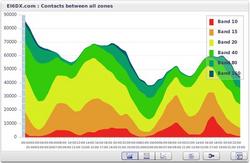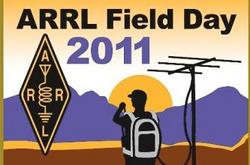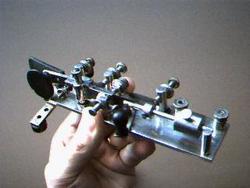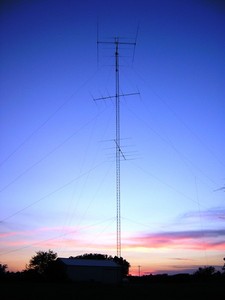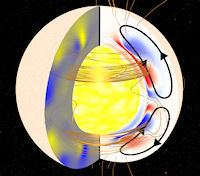 March 16, 2011 Editor: Ward Silver, NØAX | |||||||
IN THIS ISSUE
NEW HF OPERATORS - THINGS TO DO One of the most popular contests with new hams is the CQ WPX SSB in which the multipliers are call sign prefixes and everybody can work everybody. New hams can even be sought after with their 2-by-3 calls, so get in there and call CQ! You can find more information about the strange prefixes you'll hear in the Wikipedia or in the CTY (country) files used by your logging software. BULLETINS Emergency HF communications in Japan are centered on 3525, 7030, 7043, 7075, 14100, 21200, and 28.200 kHz. Please avoid these and nearby frequencies when the bands may be open to the NW Pacific Rim. BUSTED QSOS No particularly erroneous items were noted in the last issue although I continue to get email about John Denver having written "Leaving On A Jet Plane" - lots of music fans in the Contest Update readership! CONTEST SUMMARY Complete information for all contests follows the Conversation section March 19-20
March 26-27
Not wanting to steal any thunder from Hamvention award-winner W7EL, I thought it worth mentioning this time around another of the antenna modeling pioneers - Brian Beezley, K6STI. Brian's software, such as YO (Yagi Optimizer) and TA (Terrain Analyzer), were groundbreaking at their introduction, along with EZNEC. Brian's receiving loop was the first of its kind in the modern amateur literature, as well. Unfortunately for ham radio, Brian left the ham software market because of rampant pirating of his products and disregard for copyright. Just because it's "amateur" radio doesn't mean everything is free. At any rate, K6STI blazed some trails for us as well - thanks, OM.
CQ WPX SSB is coming up next weekend. In preparation, Stan EI6DX has used his Log Analyser software to parse the latest set of public WPX logs. The results allow comparison to sets of public logs for other CQ contests. Aside from the usual breakdowns by band, mode, time, and zone there are several other comparisons such as number of logs received, logged QSOs, total calls, and validated or "real" calls. Interesting stuff! A new Remote Beacon Network (RBN) Telnet cluster node is now available at arcluster.reversebeacon.net port 7000, using the latest AR Cluster Server Version 6 beta. The new node is running in parallel with the RBN node at telnet.reversebeacon.net port 7000, which uses the DXSpider node software. This new version of AR Cluster uses revised filtering syntax that makes it possible to concatenate multiple filtering commands in a single message to the cluster, which in turn makes it possible to conveniently send messages to adjust your filters from the message buttons of typical telnet clients and logging programs. (Thanks, Pete N4ZR) CW contesters are known for their ability to discriminate between signals with nearly the same frequency. The Tonometric web site provides an Adaptive Pitch test to prove your pitch-picking proficiency. There are other exercises for rhythm and even a tone-deaf test! (Thanks, Doug K1DG)
ARRL Field Day is fast approaching and with it the opportunity to demonstrate snappy HF operating techniques to potential radiosport recruits. Why not show them the ropes while attired in your finest Field Day gear? All of this year's Field Day supplies and concupiscibles are will be shipping April 1st - no fooling! While you're at it, be sure to download the Field Day packet and start plotting your bonus point collection strategy! Scrambling the contest planner plans, this year July has FIVE full weekends - If you're ever caught without a snappy answer to a less-than-snappy question, you might want to check out K3TN's Arrgh FAQ spotted on the Internet by web-crawler Bob, N6TV.
Web Site of the Week - Have you noticed that some radio network news broadcasts still begin with that "squee-click" dating from the days of manually opening the network circuit? Or that your digital camera makes a shutter noise when it captures an image - even though it doesn't have a shutter? "The Fading Sound of Analog Technologies" by David Pogue notes these and other temporal incongruities whose meaning has faded even as their aural remnants haunt our modern world. (Thanks, Bob N6TV) WORD TO THE WISE Exercise - everybody knows it's good for you, but what's the radiosport equivalent? How about a spotless weekend? Since in the WPX just about every other call sign is a multiplier, there is little incentive to obsess over ever bit of information from the spotting network. Test your tuning and band-picking skills by "going dark" in the WPX SSB contest - you'll become a savvier spot snagger for when it counts! What is "Enter-Sends-Mode" (ESM) anyway? Offered by several contest logging programs, this mode lets you do a lot with the Enter key. Call CQ? Press Enter. Send the exchange? Press Enter. Acknowledge the received information and ask for more callers? Press Enter. Pioneered in the MS-DOS TR-LOG program, many top operators find it to be efficient, but it does take some getting used to. To explain ESM, the N1MM development team has posted links to videos on using it during CW and RTTY operation. (Thanks, Larry K8UT) You can get a nice view of the W3LPL antenna array online. Click on "Bird's Eye" to get a detailed view, zoom in, and click on the compass to see images from different perspectives. You can also expand the image to the left by clicking on the left-arrow on the upper left corner of the picture. (From the ARRL Propagation Bulletin ARLP10) CQ WPX Contest Director K5ZD's "10.5 Tips for Fun and Success in the CQ WPX Contest" webinar has been posted to Potomac Valley Radio Club's web site under the Recorded Webinars link for those who missed the live version of the presentation. (Thanks, Ken K4ZW) As if you don't listen to enough QRN, NASA recorded the sounds of thousands of cometary dust particles pelting the Stardust-NExT spacecraft as it flew past Comet Tempel at 9.8 km/sec, or 24,000 mph. The audio was recorded by an instrument aboard the spacecraft called the Dust Flux Monitor which measures sound waves and electrical pulses from dust impacts. Think of that the next time a big ol' bug paints a Jackson Pollack on your windshield! (From the AMSAT ANS-065 Bulletin) Make Online has posted a video demonstration of how to use vinegar, hydrogen peroxide and salt to etch a circuit board. (Thanks, Jeff AB6MB) The bad news about aurora? It shuts down the HF bands. The good news? It's fun to look at as in this video of the Mar 9th display at the QTH of Carl WL7BDO. Needless to say, Carl didn't work much on HF that night although I understand the VHFers found plenty of excitement when beaming in this direction. (Thanks, Rich KL7RA) If you like to listen to podcasts on your daily commutes, Jack WAØRJY recommends the Astronomycast web site's selection of programs. Speaking of astronomy, should the sky be clear at sunset this week, go outside and take a look for Jupiter and Mercury above the western horizon as described by Spaceweather. It's a rare opportunity to see the largest and smallest planets together in the sky.
The initial results for the 2010 Sweepstakes CW contest have been released on the ARRL Contest Branch web site and K9LA's extended writeup for the 2010 IARU HF Championship is there, too! (Thanks, ARRL Contest Branch Manager, Sean KX9X) California QSO Party results have been released for the 2010 event with a very nice writeup by Al AD6E. The contest - already the largest of the individual state QSO parties - continues to grow in participation each year with more than 900 logs submitted for the 2010 contest. With the high bands finally showing some signs of life, the CQP is in a great position to benefit from better intra-continental propagation on 10 and 15 meters. (Thanks, David N6EN) Valery R5GA has published lists showing both 3830 claimed scores and actual log submissions for the ARRL DX SSB and CQ WW 160 SSB contests. The Catalina Radio Club is pleased to announce that the preliminary results of the 2010 Arizona QSO Party are now uploaded for your viewing pleasure. Also online are the results of the 2010 Ohio QSO Party. (Thanks, Gary KE7DX and Jim K8MR) CQ WW RTTY Contest Director, Ed WØYK, totaled up the different types of logging software used to generate the 2687 logs submitted for the 2010 contest - there were 64 varieties! OPERATING TIP I had to strive really hard to avoid using the common abbreviation for search-and-pounce operation in a tasteless fashion when referring you to this article about how a full bladder improves decision making. All part of a day's work here at the Contest Update editorial department. What could be more standardized than time? Well, lots of things, actually - it's amazing that time zone, for example, is not defined by an international standard. The database for time zones is actually maintained by a single volunteer, Arthur Olson, who is now retiring. The IANA (the folks that control Internet address structure) is at last developing a transition strategy. A tip of the temporal cap to Mr Olson! The surge in solar flux (over 150 last week!) brings a renewed vigilance on 6 meters for DX QSOs. In response, ARRL Propagation Bulletin ARLP009 had a nice report on 6 meter transequatorial propagation (TE) from PJ2T by N4QQ/PJ2. In case you were wondering, the surge in the solar flux topped out at 155, the highest level since 23 July 2004. CQ 10 meters!
While ol' Sol has been mighty active lately - the solar flux is back down to 107 on 15 Mar - there are still plenty of concerns about the ultimate fate of Cycle 24. The good news is that the recent deployment of solar science platforms in deep space have enabled scientists to formulate better theories about what causes and modulates the cycles. A recent NASA article presents one of the strongest candidates yet to explain the ups and downs of our beloved sunspots. While it doesn't predict a return to the heights of Cycle 19, a better understanding of our closest star is always a good thing. (Thanks, Jon K7ZA) Is it more important to be loud or to hear well? From Dave, N2NL/NH2T after the recent ARRL DX Phone contest, "KH2L struggled to work K3LR on 80 meters the first night but finally made it in the log. On Sunday, he checked his 60-foot vertical and discovered it was disconnected. He (had) worked K3LR on 80 meters with his loading coil! He thought the SWR was bad only because it's normally resonant in the CW sub-band." If you don't have a big shop of your own - take a long around to see if a Tech Shop is in your neighborhood. If not, mightn't this be a good project for your club? (Thanks, Tim K3LR) The winter months can be filled with static pops and sparks - just ask any Dakota Division cat! Working on sensitive electronics these days can be a perilous experience for tiny semiconductor junctions if the tool wielder isn't well-grounded. Glenn AC7ZN has found an inexpensive remedy that helps static charge find another path to the Earth than through your gadgets. He uses StaticGuard laundry spray on a weekly basis to form a high-resistance layer that dissipates static charge on workbench, chair, and carpet. The memristor - a new type of electronic component - is beginning to find niches in electronic design as described in this Technology Review article. While it's not about to appear on the licensing exam, you can be sure that if there is a way to use it in radio, hams will find it. (Thanks, Brian Fernandez) Technical Web Site of the Week - Noting recent comments recently about trans-equatorial propagation (TEP) on VHF bands, Roger VK2ZRH writes, "For the benefit of newcomers to TEP, I have two web pages that each give a detailed introduction to afternoon and evening TEP, written over 2006-2007 and posted in 2007. Also, the Australian IPS Radio Space Services offers an article on TEP." (From ARRL Propagation Bulletin ARLP010) Welcome Back!
I don't know about you, but my reaction to the electrifying conditions during the ARRL DX Phone contest was a huge sigh of relief. To hear 10 meters full of signals - strong signals! - to well above 28.500 MHz filled an empty spot in my radio heart that I'd nearly despaired of ever seeing filled again. Oh sure, I love the low bands and chase gray line DX with all the enthusiasm of the next guy but those bottomless bands of 10 and 15 meters when the F2 layer lights up...well, there's nothing quite like it. We just missed the big openings during the ARRL DX CW contest - you could feel the band trying its best, leaking a little signal from the biggest stations through path closed for years. On Saturday, the dam began to crack. On Sunday, the floodgates opened! On the East Coast where I was operating we found ourselves competing to get through to Europe. I have never been so pleased to get beaten out by the 9s and Øs! Out west, call signs from the Land of the Rising Sun filled high-band logs that had been empty for a long time. South American stations pounded in from sunrise to way past sunset. Short skip, long skip, even a smidgen of long path made an appearance. We've been telling the new hams about the wonders of DX contesting without all the massive QRM on 20 meters and down. I'm sure they were beginning to think we were barmy or at least telling some tales. Here was the opening act for several dramas to come, when 10 and 15 swell nigh on to busting at the seams with signals nearly any station can log.
Just two months ago, we were wondering if Cycle 24 was going to flop back into the solar ocean like a spent booster, remember? Black humor made the rounds - not only was the solar minimum past, but the maximum, too! Argggh! To be sure, there will be quiet periods and disturbed days when it seems the sunspots have evaporated once again, but not for long. So the Big Bass Bongo has been beaten and the Palos Verde Sundancers have danced their propagation dance. The Sun has heard their siren song and sung its own verses in response. Laissez les bons temps rouler! 16 March through 29 March An expanded, downloadable version of QST's Contest Corral in PDF format is available. Check the sponsor's Web site for information on operating time restrictions and other instructions. HF CONTESTS NAQCC Monthly QRP Sprint--CW, from Mar 17, 0030Z to Mar 17, 0230Z. Bands (MHz): 3.5-14. Frequencies: Monthly on 2nd Tuesday or 3rd Wednesday (alternating). Exchange: RST, S/P/C, and NAQCC member number or power. Logs due: 4 days. Rules Feld-Hell Rolling Sprint--Digital, from Mar 19, 12 PM to Mar 19, 2 PM. Bands (MHz): 1.8-28. Frequencies: Monthly on 3rd Saturday. Exchange: RST, QTH, Feld-Hell number. Rules 10-10 Mobile QSO Party--Phone,CW,Digital, from Mar 19, 0001Z to Mar 19, 2359Z. Bands (MHz): 28. Exchange: Call, name, county & S/P/C, 10-10 number. Logs due: Apr 2. Rules BARTG HF RTTY Contest--Digital, from Mar 19, 0200Z to Mar 21, 0200Z. Bands (MHz): 3.5-28. Exchange: 3-digit serial and 4-digit time. Logs due: May 1. Rules OK1WC Memorial Contest--Phone,CW, from Mar 19, 0500Z to Mar 19, 0800Z. Bands (MHz): 1.8 - 7. Exchange: RS(T) and serial. Logs due: 14 days. Rules Russian DX Contest--Phone,CW, from Mar 19, 1200Z to Mar 20, 1200Z. Bands (MHz): 1.8-28. Exchange: RS(T), serial or oblast abbr. Logs due: 45 days. Rules Oklahoma QSO Party--Phone,CW,Digital, from Mar 19, 1300Z to Mar 20, 0200Z and Mar 20, 1400Z to Mar 20, 2000Z. Bands (MHz): 3.5-28, 50, Frequencies: Multiple operating periods; CW 3.545, 7.045, 14.045, 21.045, 28.045; Phone 3.860, 7.260, 14.260, 21.360, 28.360. Exchange: RS(T) and OK county or S/P/"DX". Logs due: Apr 30. Rules North Dakota QSO Party--Phone,CW, from Mar 19, 1800Z to Mar 20, 1800Z. Bands (MHz): 1.8-28, 50,144. Exchange: RST and ND county or S/P/C. Logs due: May 1. Rules Virginia QSO Party--Phone,CW,Digital, from Mar 19, 1800Z to Mar 21, 0100Z. Bands (MHz): 1.8-28, 50-440, Frequencies: CW 1.805, 50 kHz+ band edge; Phone 1.845,3.86,7.26,14.27,21.37,28.37; 50.130, clg freq 144/220/440. Exchange: Serial and VA county/city or S/P/C. Logs due: Apr 15. Rules CQ WPX SSB Contest--Phone, from Mar 26, 0000Z to Mar 27, 2400Z. Bands (MHz): 1.8-28. Exchange: RS and serial. Logs due: 28 days. Rules VHF+ CONTESTS Oklahoma QSO Party--Phone,CW,Digital, from Mar 19, 1300Z to Mar 20, 0200Z and Mar 20, 1400Z to Mar 20, 2000Z. Bands (MHz): 3.5-28, 50, Frequencies: Multiple operating periods; CW 3.545, 7.045, 14.045, 21.045, 28.045; Phone 3.860, 7.260, 14.260, 21.360, 28.360. Exchange: RS(T) and OK county or S/P/"DX". Logs due: Apr 30. Rules North Dakota QSO Party--Phone,CW, from Mar 19, 1800Z to Mar 20, 1800Z. Bands (MHz): 1.8-28, 50,144. Exchange: RST and ND county or S/P/C. Logs due: May 1. Rules Virginia QSO Party--Phone,CW,Digital, from Mar 19, 1800Z to Mar 21, 0100Z. Bands (MHz): 1.8-28, 50-440, Frequencies: CW 1.805, 50 kHz+ band edge; Phone 1.845,3.86,7.26,14.27,21.37,28.37; 50.130, clg freq 144/220/440. Exchange: Serial and VA county/city or S/P/C. Logs due: Apr 15. Rules LOG DUE DATES 16 March through 29 March March 17 - NAQCC-EU Monthly Sprint March 18 - YL-ISSB QSO Party, CW and SSB March 18 - SKCC Weekend Sprint March 19 - North American Sprint, RTTY March 20 - AWA Amplitude Modulation QSO Party March 21 - ARRL School Club Roundup March 21 - DARC 10-Meter Digital Contest March 21 - ARRL International DX Contest, CW March 26 - HA3NS Sprint Memorial Contest March 29 - REF Contest, SSB ARRL Information Click here to advertise in this newsletter. Your One-Stop Resource for Amateur Radio News and Information ARRL membership includes QST, Amateur Radio's most popular and informative journal, delivered to your mailbox each month. Subscribe to NCJ - the National Contest Journal. Published bimonthly, features articles by top contesters, letters, hints, statistics, scores, NA Sprint and QSO Parties. Subscribe to QEX - A Forum for Communications Experimenters. Published bimonthly, features technical articles, construction projects, columns and other items of interest to radio amateurs and communications professionals. Free of charge to ARRL members: Subscribe to The ARRL Letter (weekly digest of news and information), the ARES E-Letter (monthly public service and emergency communications news), Division and Section news -- and much more! ARRL offers a wide array of products to enhance your enjoyment of Amateur Radio. Visit the site often for new publications, specials and sales. Donate to the fund of your choice -- support programs not funded by member dues! ACKNOWLEDGEMENTS ARRL Contest Update wishes to acknowledge information from WA7BNM's Contest Calendar and SM3CER's Contest Calendar. | |||||||
